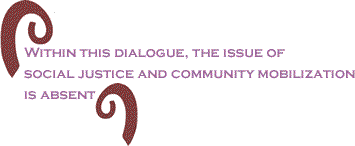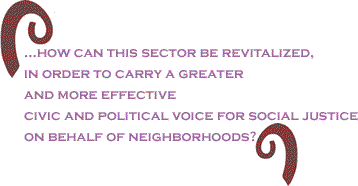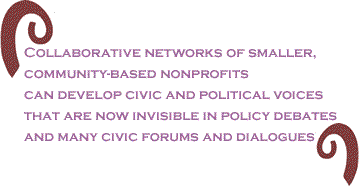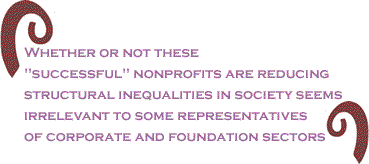
|
|||||||||||||||||||||
|
||||||||||
|
||||||||||
 |
||||||||||
 |
||||||||||
NOTE: This essay is based on a longer article by James Jennings and Ricardo Torres, Community Based Nonprofits in U.S. Inner Cities: Collaborative Strategies for Community-Building to be published in Sage Race Relations Abstracts vol. 32 (4), 2007) Community-based nonprofits, operating in low income urban neighborhoods, have a long history of emphasizing economic democracy through the mobilization of community residents. Today, smaller community-based nonprofits continue to provide a range of services that are critical for the social and economic well being of urban neighborhoods. In the U.S., these neighborhood-based nonprofits, with budgets under $5 million, and even less than $1 million, are engaged in charitable and economic activities that touch every aspect of neighborhood life. In many instances, they provide voice to collective interests and needs that are not typically heard in venues of power and wealth. Recent civic dialogue about the future of nonprofits in this country, however, tends to overlook the role and impact of this sub-sector of nonprofits. The public and corporate focus is on downsizing and mergers, performance and outcome measures, or standards of accountability. And, within this dialogue, the issue of social justice and community mobilization is absent. Community-based organizations in communities of color must return to their original mission on behalf of social justice, advocacy, and political mobilization of residents. This call, for greater emphasis on civic and political mobilization on the part of smaller, community based nonprofits, is consistent with political and economic developments today. As the concentration of wealth spirals upward, and government seeks to distance itself from safety-net activities, the collective political voice of neighborhood-based nonprofits becomes crucial for representing the needs of residents and local communities. At one end of the spectrum of the overall nonprofit world are institutions with hundreds of employees, millions of dollars in revenue, and millions of dollars in operating expenditures, and in some cases, endowments worth billions of dollars. At the other end, there are the small nonprofits with staffs of a few people, and budgets and operating expenditures that primarily are based on yearly foundation grants. The latter sector is also distinguished from the "biggies" in that they tend to have community roots where they operate. The organizations were founded by community residents, and they have become part of the social fabric of the local neighborhood.
Community-based nonprofits assist in making impoverished and working-class residents and citizens aware of important benefits that can improve their living conditions. Community-based nonprofits can inform government and foundations as to what are the immediate and changing needs in specific communities. Nonprofits make the program connections between the availability of social welfare and outreach and accessibility. They are the implementors of the missions of foundations, and therefore vital to the work of this sector. These organizations have the capacity, sometimes missing in government and the private sector, to “explain” policy and related services in ways that are culturally, socially, and linguistically resonant with the target population. The impact of smaller nonprofits has not been widely documented. Except for a few select examples, the general public does not have a good understanding of how local living conditions in low-income and impoverished neighborhoods are intertwined with the fate of the smaller nonprofits. Despite an important role in low-income neighborhoods, this sector does not have the resources or revenue to promote their services and image on a larger scale, as is the case with much bigger nonprofits. In spite of this limitation, community-based nonprofits working in low-income and impoverished urban areas, have provided voice to residents and have helped to challenge public policies and corporate practices that exploit residents and local workers. These kinds of organizations have helped to build and strengthen neighborhoods. Collectively, this sector of nonprofits represent a critical component of society’s safety-net. Nonprofits play an important, though at times unrecognized, economic role in many communities. In low-income and working-class urban neighborhoods, these kinds of nonprofits assist local and small businesses, build and rehabilitate physical infrastructure, employ and train many workers, and provide access to educational and economic opportunities. A number of studies document the considerable economic contributions of community-based nonprofits. This is ironic in that many of these organizations are financially strapped. The sector, as does its much larger counterparts such as hospitals, universities, and national organizations, raises and expends hundreds of millions of dollars every year on health , education, housing, recreation, the environment, the arts, and other areas. But they tend to have a more focused and concentrated effect in some communities, as local spenders. As local entities, they contribute, along with businesses, to the community, by spending money and increasing disposable income by paying wages, rents and fees. There are literally thousands of people employed by this sector. Community-based organizations help to make neighborhoods more livable and attractive to businesses and have become a channel for the employment of disadvantaged workers, women, and people of color.
In earlier periods, these kinds of organizations also focused on the mobilization of residents interested in pursuing social and economic justice for their neighborhoods. They provided political voice to residents, and demanded resources and services for the neighborhood. Given this kind of history and impact, why have community-based organizations seem to have weakened over a period of time, and more importantly, how can this sector be revitalized, in order to carry a greater and more effective civic and political voice for social justice on behalf of eighborhoods? In spite of important accomplishments in improving living conditions and providing services in urban areas, today, this sector faces challenges that undermine the capacity of smaller nonprofits. Neighborhood organizations have experienced significant reductions in resources while the demand for services has increased. In some cases, funders of these organizations, including foundations and corporate philanthropists, are now demanding a greater return on their "investments" which are made in the form of grants. Increasingly, this demand is taking the form of seeking measurable outcomes – within very short time frames. Unless they meet these new standards, neighborhood-based nonprofits are being encouraged to close, or to merge with larger, (though not necessarily more efficient or effective) nonprofits. In other instances, smaller nonprofits are losing access to federal assistance that is being re-directed to large universities and giant nonprofits. Under these circumstances, it becomes difficult for individual neighborhood-based nonprofits to focus on their traditional community-building and organizing roles. Devolution, the shift of governmental responsibilities from the federal level to the states, economic transformations, changing demography, and the continually spiraling of the concentration of wealth, are producing fiscal stress for this sector. Further, calls for utilization of faith-based organizations and free-market approaches in the delivery of public services affect community-based organizations, as they pursue their missions to help people at the neighborhood level. Community-based nonprofits must carry out their missions within a context of fiscal cutbacks, environmental emergencies and disasters on the local, national and international levels, political uncertainties, widening income gaps and inequality, increasing skills gaps, increasing technology and infrastructure gaps, and increasing needs for services. And they endeavor to carry out their missions while government is scaling back and some foundation spokespersons are presuming that bigger nonprofits are naturally better. Additionally, foundation and corporate spokespersons have raised criticisms about the impact, or lack thereof, of community-based nonprofit services on social and economic problems. Nonprofits are perceived by some of these people as lax in pursuing and adopting organizational efficiencies to reduce repetition or duplication of services. There are concerns about redundancy as a consequence of rapid growth of this overall sector, and whining complaints about the degree of dependency of nonprofits on state government and foundation funding.
For example, in one recent guest column appearing in the Boston Globe, entitled, Too many do-gooders (May 3, 2007), Kevin Phelan and Chad Gifford ponder that “…we have an expansion of agencies at a time when the number of corporate donors continues to shrink. Of course, this comes when the needs have never been greater. The solution is that Boston must create a new paradigm with interested and strong-willed civic leadership willing to examine the duplication of services. Leaders such as the United Way, The Boston Foundation, the Greater Boston Chamber of Commerce, and small groups of others from the profit and nonprofit world must convene and examine the number of agencies that can be the framework of this vital service component. Obviously any commission must involve political leaders, who are familiar with the problems and challenges that exist.” They add, “Wouldn’t it be great if a university volunteered to tackle this project?” The call for this kind of civic dialogue not only tends to weaken neighborhood organizations in low-income places, but also mutes the civic and political voices of residents in these same places. The call here is essentially a top-down dialogue, based on the presumption that there are too many do-gooders. This is interesting, in light of the statement made by these authors to wit, “…when the needs have never been greater.” How can there be too many do-gooders in this context, a context that reflects persistent and greater poverty and economic distress at a time when wealth continues to be amassed by lesser and lesser numbers of people? This is the wrong paradigm and it will not work or lead to the improvement of living conditions for people in our low-income neighborhoods. Strategic Collaboration: A Civic and Political Tool for Neighborhood-based Nonprofits In a forthcoming article, Community Based Nonprofits in U.S. Inner Cities, James Jennings and Ricardo Torres propose a mechanism, “structural collaboration,” that can represent a way for enhancing the collective civic voice of community-based nonprofits, and thereby help to enhance their effectiveness and impact on social conditions. A few successful individual nonprofits are not enough to ensure the organizational health and vibrancy of this sector, or more importantly, the well-being of residents in impoverished neighborhoods – places that reflect disinvestment on the part of government, and exploitation by powerful corporate interests. Individual nonprofits in local areas will have to reflect greater strategic collaboration, advocacy and mobilization, on behalf of neighborhood interests, in order to effect positive change. This framework can facilitate the strengthening of community voices in civic dialogues about the future of smaller nonprofits, encourage foundations to reflect qualitative and comprehensive input from community organizations about what a community agenda should look like and entail and provide a venue for considering time frames for understanding and assessing social change.
The leadership of community-based nonprofits and local residents must consider how to raise and mobilize a collective civic voice in order to change political and economic transformations that point to lesser resources and greater demands upon this sector. This is essential, so that residents can have some input regarding strategies for improving living conditions in the places they live and work. This is not to discourage greater attention to the issue of accountability and impact, but the essentially corporate-based, top-down managerial call for performance measures, or showing impact, or the reduction of duplication, or the sharing of costs and resources is a paradigm divorced from attention to structural inequalities. Organizational effectiveness in becoming more accountable and being able to measure impact should not be divorced from the continual need to strengthen the collective political and economic muscle of low-income people in addressing social justice issues. Not doing this, means that the discussion of accountability and standards will be dominated by corporate interests that can represent agendas inimical to the well-being of poor and working-class people, and their neighborhoods. The pursuit of organizational initiatives to improve efficiency and effectiveness is important but this discourse must move beyond simply sharing costs for printing or cutesy ways for raising more donations. A collective and consistent civic voice, expressing concerns about challenges facing economically distressed neighborhoods, and led by the representative voices of neighborhood-based nonprofits, can emerge as a key political tool in some places. Collaborative networks of smaller, community-based nonprofits can develop civic and political voices that are now invisible in policy debates and many civic forums and dialogues. Programmatic, rather than strategic collaboration between nonprofits, can include a range of efforts aimed at generating organizational efficiencies and improvement in the delivery of services. Strategic collaboration includes actions on the part of nonprofits to create or identify collective impact on a community challenge or problem. It includes planning and actions to create, identify or advocate on behalf of community-wide interests and agendum for improving local living conditions. This means that community-based organizations in inner cities, interested in increasing the economic well-being of neighborhoods, must re-organize themselves into collaborative, and essentially, political entities. It is the only way this sector can continue its work to improve living conditions at the local level. It is the only way the current relationship of recipiency with foundations will change. This call, by the way, does not violate any laws or regulations pertaining to activities on the part of nonprofits. The leadership of community-based organizations must not forget that they can talk with each other, and plan with each other. This does not violate anything.
Neighborhood or place-based strategic collaboration should be supported by community-based organizations because it is a way to enhance the sector’s collective political, economic, and civic roles. Sometimes there are too many voices that are having individual conversations with foundations and state government. And, while solo nonprofits may enjoy strong reputations with foundations and state government, it is a framework of strategic collaboration that will mean more resources, and a greater level of equitable distribution of such, for low-income and impoverished people. It will be easier for nonprofits to be creative, entrepreneurial, and bold in their approaches if they begin to think and act more collectively in a civic and political sense. Under the current period of globalization and neoliberalism, terms like "strategic philanthropy", "social ventures" and "social entrepreneurship" have emerged as a way to assess – and control - the work of community-based nonprofits. Strategic philanthropy suggests, in part, that foundations and corporations become more investment-oriented and targeted in how they work with nonprofits. Implicit in this call is the belief that approaching grant-making as an investment creates value. Social venturing involves the tapping of donors to use investment strategies to support socially worthy and efficient enterprises. Under this framework, organizations seek to pool resources of philanthropists and donors in order to invest in nonprofit organizations. But this approach does not involve merely providing a grant. A relationship is established between the venture firm and the nonprofit that allows the former to share its organizational expertise. These initiatives seem reasonable from a "purely rationalist" point of view, but how will it really resolve problems associated with inequality and a history of neighborhood disinvestments? These ideas can be applied in a Darwinian manner, where only the "strongest survive." Interestingly, terms like "strong" and "lean and mean," in the nonprofit sector, usually indicates who is raising the most money, rather than which organizations are improving living conditions for impoverished and low-income groups. Whether or not these "successful" nonprofits are reducing structural inequalities in society seems irrelevant to some representatives of corporate and foundation sectors. Too easily, urgings for greater efficiency and impact presume that the social and economic problems facing low-income neighborhoods and impoverished residents are merely managerial issues. That is, a tighter-run organization, with enlightened and tough leadership, can make a difference. One can only stand back in awe at the implication that problems based in structural inequalities, such as joblessness, poverty, poor schooling, poor housing and homelessness, can be resolved by insisting – simplistically - that community-based organizations become more efficient, lean and mean. Equally illogical and harmful is how certain foundations decide what should be funded, how it should be funded, and how the funding should be evaluated, without qualitative input from community-based organizations. Encouraging community-building activities that are planned collaboratively and strategically to establish community-wide agendum can discourage faddist-driven grant-making. There should be concern that some foundations seem more supportive of what they find exciting or avant-garde, rather than what nonprofits and community groups might consider important.
Some now believe that competition among nonprofits, rather than collaboration, can increase organizational efficiencies of smaller nonprofits in urban communities. Presumedly, this will occur because individual organizations will be forced to work harder and more effectively, lest they are closed or eliminated. The call for more competition in the latter sense does not come without a price or concerns. First, this call is not applied equally across the nonprofit spectrum. It is a call that can actually weaken the position of the smaller nonprofits vis-à-vis the biggies, who might have institutional agendum inimical to neighborhood interests. The effects of competition will be skewed in favor of the biggies. Competition, as a policy tool, will hurt smaller nonprofits while not addressing incompetence or ineffectiveness on the part of larger nonprofits, since the larger nonprofits have more resources to resist proposed changes or scrutiny. Here, again, without a strong political and collective voice, a framework based on competition places the smaller and community-based nonprofits at a great disadvantage compared with the much bigger nonprofits. Conclusion Nonprofits require a mechanism that will allow organizations to share ideas and pursue and implement a framework of strategic collaboration on behalf of neighborhood-wide interests. The establishment of nonprofit consortia, in local neighborhoods, can result in enhancing the collective civic and political influence of smaller and community-based nonprofits and increase possibilities of collaboration in terms of programs and services. Nonprofits should consider formal consortia that encourage common risk-taking within neighborhood-based zones. Of course, nonprofits should establish geographically-based consortia for increasing efficiencies but the more important reason is to increase collective civic – and political - clout. Advantages to nonprofit consortia could include more effective communication and exchange of information about community concerns, better understanding of how to utilize resources to trigger positive community changes, help to create best practices in the delivery of services and, show impact more clearly and effectively. Civic and political consortia can also become a response to the broad challenges facing smaller nonprofits and a way for the sector to have voice in the rising call for accountability.
Accomplishing this will be initially very difficult, since there is a range of organizational, turf, cultural, philosophical and fiscal issues that obstruct moving in this direction. It will also be resisted by interests who are threatened by the political potential of community-based nonprofits working together on civic and political agendum. But there is one thing that immediately provides a basis for collaboration: deteriorating living conditions in the communities being served. Improving living conditions for all residents is an idea that can be the glue for collaborative and community-wide agendum. Collaborative and geographic networks of community-based organizations in economically neglected neighborhoods can provide space and encourage greater civic involvement and participation in discourses focusing on social justice. Collaborative networks of community-based organizations can help to mold and legitimize community-wide agendum to address economic challenges and expectations about the role of the private sector and foundations in helping to resolve these challenges. Only in this way will the smaller, community-based nonprofits survive and be able to continue providing services and resources to clients, while continuing with missions aimed at building vibrant and healthy neighborhoods for all people. BC Editorial Board member James Jennings, PhD is a professor of urban and environmental policy and planning at Tufts University. Ricardo Torres is the founder and CEO of Venture~Preneur Consulting
(VPC) – a Click here to contact Dr. Jennings and Mr. Torres. |
||||||||||
| September
20, 2007 Issue 245 |
|
| Printer Friendly Version in resizeable plain text format format |
 |
 |
 |
| |
| |







































